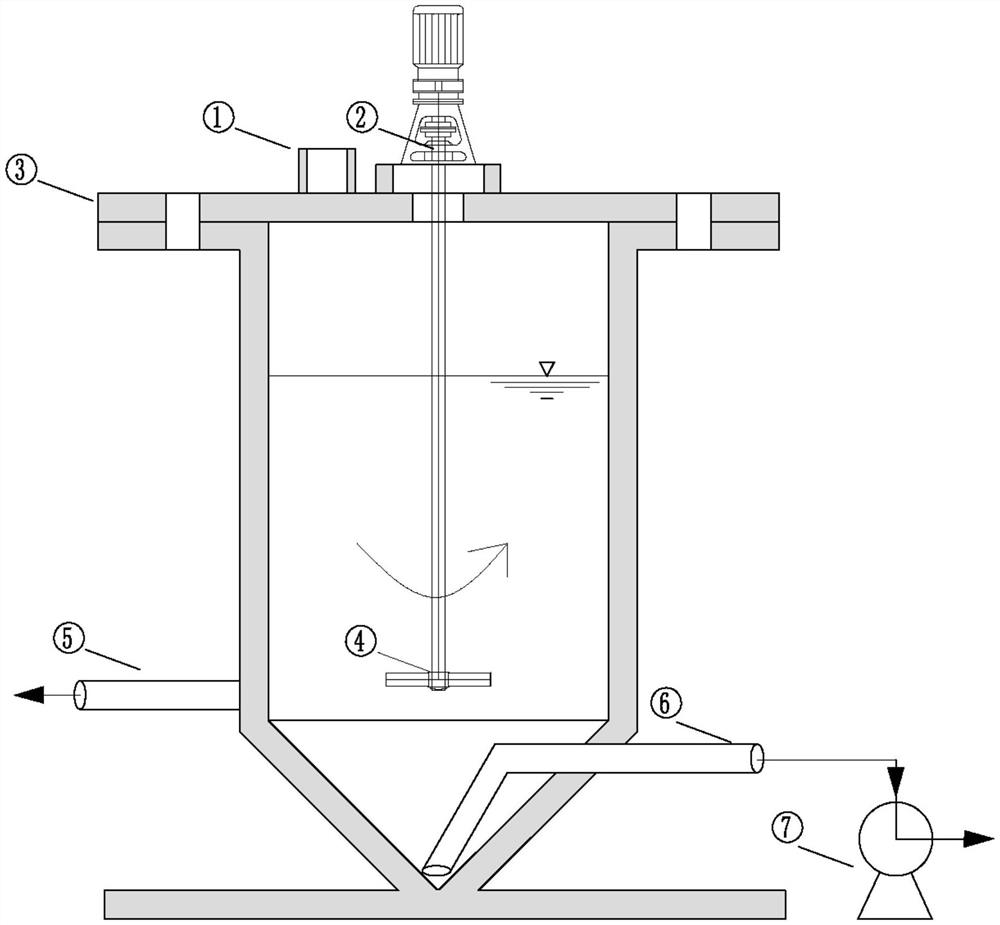A treatment method for water bodies polluted by radioactive iodide ions
A technology of ion pollution and radioactive iodine, which can be used in radioactive purification, nuclear engineering, etc., and can solve the problem of low utilization efficiency of adsorbents
- Summary
- Abstract
- Description
- Claims
- Application Information
AI Technical Summary
Problems solved by technology
Method used
Image
Examples
Embodiment 1
[0034] Embodiment 1: utilize described method to process the distilled water that contains 5.00mg / L radioactive iodide ion. The volume of water polluted by radioactive iodide ions added to the reactor is 200mL, and the nanometer Cu in the reactor 2 The dosage of O / Cu-C adsorbent is 1.0g / L. The dilution factor F was chosen to be 0.200. The mechanical stirring speed of the first-stage adsorption is 200 rpm. The contact time between the adsorbent and the water polluted by radioactive iodide ions is 90 minutes. The static settling time of the adsorbent in the stage of draining out the old adsorbent is 3 minutes. The flow rate of the pump to discharge the old adsorbent is 80mL / min, and the volume of the solution taken by the old adsorbent out of the reactor is 10.0mL. Nano-Cu in the second-stage adsorption of the two-stage countercurrent adsorption process 2 The dosage of O / Cu-C adsorbent is 1.0g / L. In the effluent stage, the effluent volume is 160mL. The specific operation ...
Embodiment 2
[0035]Embodiment 2: Utilize described method to process the distilled water water body containing 20.0mg / L radioactive iodide ion. The volume of water polluted by radioactive iodide ions added to the reactor is 200mL, and the nanometer Cu in the reactor 2 The dosage of O / Cu-C adsorbent is 1.0g / L. The dilution factor F was chosen to be 0.400. The mechanical stirring speed of the first-stage adsorption is 200 rpm. The contact time between the adsorbent and the water polluted by radioactive iodide ions is 120min. The static settling time of the adsorbent in the stage of draining out the old adsorbent is 5 minutes. The flow rate of the pump to discharge the old adsorbent is 100mL / min, and the volume of the solution taken away by the old adsorbent out of the reactor is 10.0mL. Nano-Cu in the second-stage adsorption of the two-stage countercurrent adsorption process 2 The dosage of O / Cu-C adsorbent is 1.0g / L. In the effluent stage, the effluent volume is 160mL. The specific o...
Embodiment 3
[0036] Embodiment 3: Utilizing the method to treat tap water containing 2.00 mg / L radioactive iodide ions. The volume of water polluted by radioactive iodide ions added to the reactor is 200mL, and the nanometer Cu in the reactor 2 The dosage of O / Cu-C adsorbent is 1.0g / L. The dilution factor F was chosen to be 0.200. The mechanical stirring speed of the first-stage adsorption is 200 rpm. The contact time between the adsorbent and the water polluted by radioactive iodide ions is 60 minutes. The static settling time of the adsorbent in the stage of draining out the old adsorbent is 3 minutes. The flow rate of the pump to discharge the old adsorbent is 80mL / min, and the volume of the solution taken by the old adsorbent out of the reactor is 10.0mL. Nano-Cu in the second-stage adsorption of the two-stage countercurrent adsorption process 2 The dosage of O / Cu-C adsorbent is 1.0g / L. In the effluent stage, the effluent volume is 160mL. The specific operation process of the ex...
PUM
 Login to View More
Login to View More Abstract
Description
Claims
Application Information
 Login to View More
Login to View More - R&D
- Intellectual Property
- Life Sciences
- Materials
- Tech Scout
- Unparalleled Data Quality
- Higher Quality Content
- 60% Fewer Hallucinations
Browse by: Latest US Patents, China's latest patents, Technical Efficacy Thesaurus, Application Domain, Technology Topic, Popular Technical Reports.
© 2025 PatSnap. All rights reserved.Legal|Privacy policy|Modern Slavery Act Transparency Statement|Sitemap|About US| Contact US: help@patsnap.com

